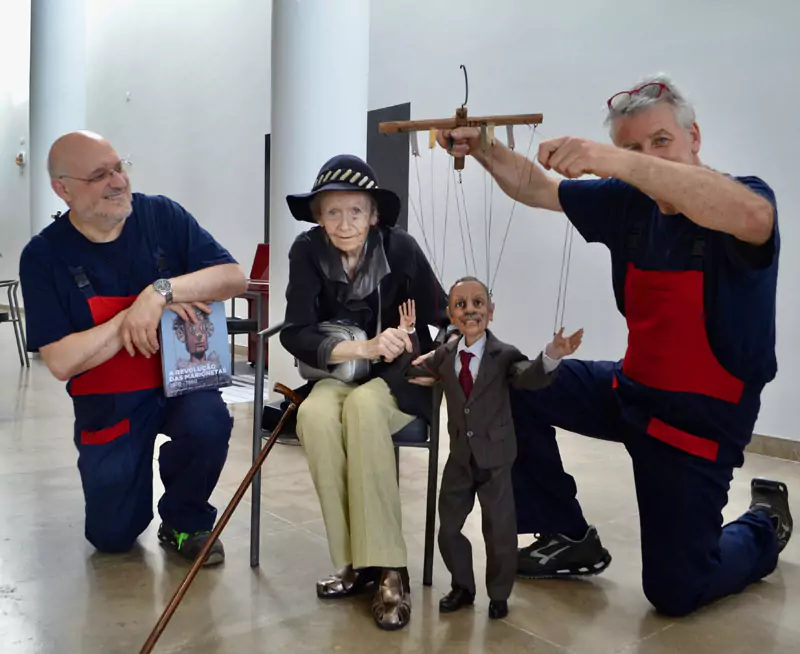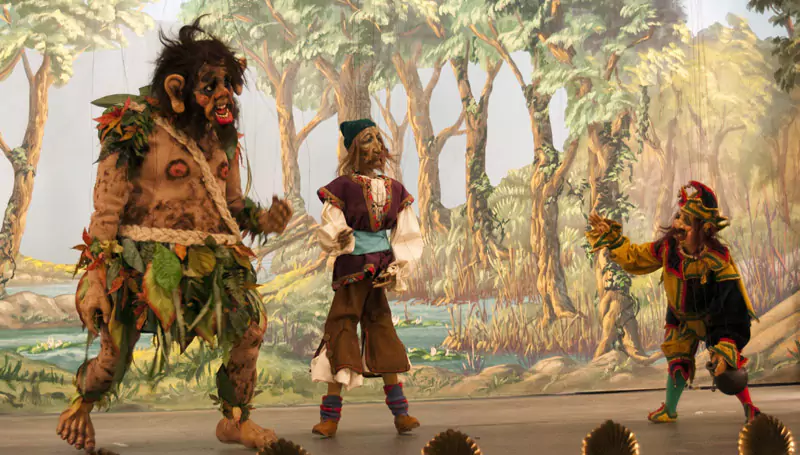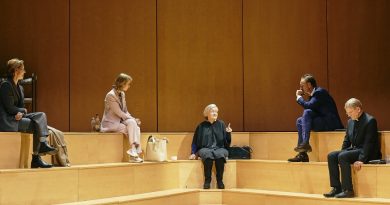“La Tempesta”, Compagnia Marionettistica Carlo Colla & Figli, Festival de Almada
Jeremy Malies in Almada, Portugal
9 July 2025
Every time I thought this production of The Tempest had achieved lift-off there was a break in momentum and things came crashing to earth through ill-judged decisions.

Compagnia Marionettistica presents Eduardo de Filippo puppet to Helena Vaz, Portuguese puppet pioneer.
Photo credit: Pedro Castanheira.
It seems an odd medley: over 150 puppets (showing varying levels of insight by their creators into the source material) are presented with pre-recorded dialogue. Shakespeare’s text has been translated by the revered Neapolitan playwright and director Eduardo De Filippo.
Well – almost. In fact, the translation of the English is by De Filippo’s wife, Isabella Quarantotti. De Filippo then translated Quarantotti’s Italian into rhymed and highly alliterative Neapolitan. This is the language spoken in Naples, the city’s immediate metropolitan surroundings, and the Campania region. But we’re still not quite there – that would be too simple!
De Filippo translated the Italian into what he imagined the Neapolitan language would have been like in the 17th century. The text has then been rendered into Portuguese for the Almada audience as captions at the side of the stage. We hear De Filippo voicing all the male characters in his notion of Neapolitan. Doing this was among his last activities and he died within weeks of making the recordings in 1984. De Filippo and Prospero are both in their death throes and we hear one of the great figures of Italian theatre voicing not just the character’s final gestures but what many of us see as Shakespeare’s farewell to the stage. And yet an experience that should be transportive remains prosaic.

Helena Vaz receives catalogue of the Portuguese National Puppets Museum.
Photo credit: Pedro Castanheira.
However heretical my reaction (and there was poignancy as a puppet of De Filippo was walked on stage at the close) I would say that the intonation of the voiceovers made them sound like John Gielgud on a slow day speaking in Latin or Esperanto and in stylized actor-laddie mode. The piece has earned plaudits at the Venice Biennale where it was staged in 1985 after a suggestion by then director of theatre Franco Quadri so I feel all the more disrespectful. It should also be said that the production has returned to the Festival de Almada from last year having been voted the best show by audience members.
It was not lost on me that this project is family-orientated or at least caters for all ages. But I saw only a handful of children in the audience, and with a running time of two hours (including an interval) it would be a stoical child who could concentrate throughout let alone read the titles non-stop.
Just for once, I liked the now inevitable post-colonial lens on the play. And here it comes in the unexpected form of Moors who I took to be captives at the Milanese court. So, it’s a given that there have already been acts of colonization in this society. “How can one see the court?” is an obvious question. I take it that Prospero is seeing all this in his mind’s eye. It’s Caliban who is the usual vehicle for a post-colonial view. Here, the puppet-makers have him look like Shrek and with Jungle Book overtones. It’s all broad brush and renders a nonsense of the most poignant lines in the play, “You taught me language; and my profit on ’t / Is, I know how to curse …”
Music lurches from glockenspiel-infused instrumental to snatches of Baroque opera. I was constantly thinking of alternative ways of doing this which was hardly a good sign. Apart from the obvious option of pure puppetry with no dialogue (I once saw the whole play as shadow puppetry at Edinburgh) it even occurred to me that it could be operatic arias and recitative.
Of course, there are moments of inspired puppetry and set manipulation here. The shipwreck is conveyed masterfully, not just the ship foundering but its breaking apart. Witty, precise puppetry movement abounds: a dog catches hold of fabric in Trinculo’s costume, Ariel (having made division of himself and proving truly sprite-like) scatters glitter over the lovers. And the puppeteers were quite rightly greeted ecstatically when they emerged onto the apron of the stage. Trinculo, who has taken over Stephano’s drunkenness, was for me the character best encapsulated by his puppet. But the scene-painting is stylized almost to the point of suggesting little effort. Something more minimalist or expressionistic would have worked better.
It was difficult not to think that less would prove more. Loose ends that are not in the Shakespeare have to be tied up by a Rococo deus ex machina figure who is lowered on a swing. Miranda becomes involved unaccountably in a dance troupe of figures with commedia dell’arte masks. At first, I thought this phase had degenerated accidentally into a Punch and Judy end-of-the-pier routine, but the transition was deliberate. We see Pierrot figures, and the Ceres and Juno story is acted out.
I should like to have seen less of this kind of extravagance and more of Ferdinand and Miranda’s courtship. I’m always touched by Ferdinand rather enjoying the task of cutting wood if Miranda (she is voiced by Naples-born Imma Piro) is around to watch him flex his muscles. This kind of comedy would surely work well with puppets but is overlooked.
Prospero should be seen to deliberately void himself of power, gravitas, and responsibility, with the final speeches cascading over us. Here, the magician-scholar duke who should be mesmerizing splutters to an ending with no pathos. I respect all the endeavour here and the stature of the people involved. Normally a play that has audiences pondering how boundaries can be pushed, this production as originated by De Filippo seldom chimed with me.









